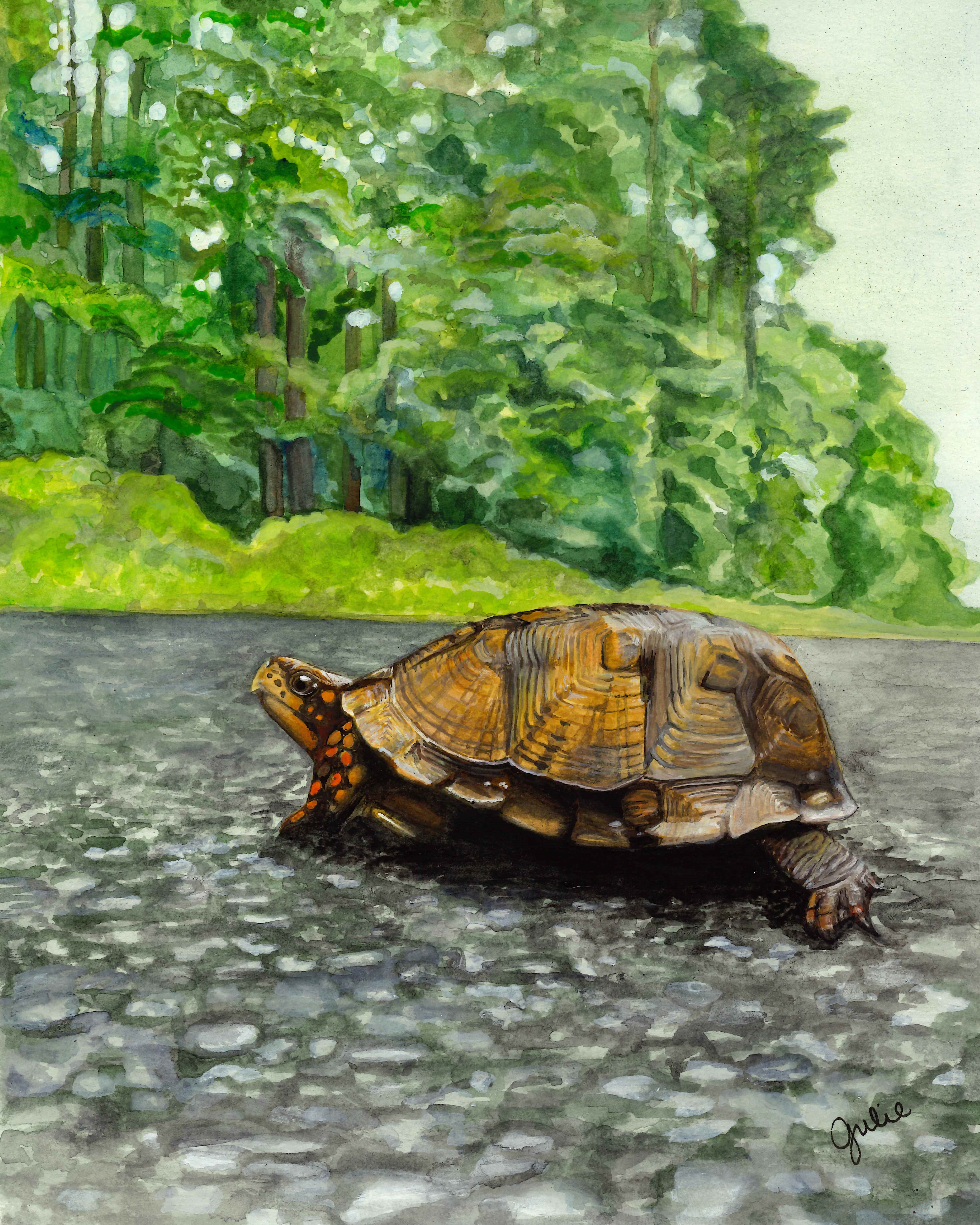This past spring, Julie snapped this photo of an Eastern Box Turtle crossing Horns Point Road which she later used as the model for this watercolor painting. The image captures so much! It exhibits the beauty and unique appearance of box turtles while also nodding to one of their leading mortal threats. To me, it conjures the fable of the tortoise and the hare, but with the ominous twist that the speedy opponent out of sight is not a spritely hare but a genuinely threatening vehicle bearing down on asphalt.
Appearance and Lifestyle
Did you know that the eastern USA is a global hot spot for turtle diversity? (I say turtle here, to mean all Chelonia, which includes all turtles, tortoises, and terrapins). This area is second only to Southeast Asia in species richness for these wonderfully weird, slow, and long-lived animals.
Among the most widespread of turtles in North America is the Eastern Box Turtle, Terrapene carolina carolina. (The second ‘carolina’ refers to their subspecies name, and they are indeed the state reptile of North Carolina). Eastern box turtles are easily recognized by their distinctive high-domed shells decorated with yellow, orange, and brown patterns, and they are found in all eastern states from Florida to southern Maine and extending west to Illinois and Louisiana. The Eastern Box Turtle is smaller than other box turtles, and sports 4 toes instead of 3 like their relatives. But like their kin, they embrace a slow and long-lived lifestyle, with longevity reported to 100 years in the wild (though more commonly 50-80 years), which has been successful for their persistence for millions of years.
As with most reptiles, the eastern box turtle is cold blooded (in technical language, “ectothermic”), meaning temperature governs their activities year-round and they are adapted to handle seasonal temperature changes in ways remarkably different from our own. In the winter, for example, unlike many animals that store fat as energy reserves, Eastern Box Turtles allow themselves to freeze solid and later thaw out by producing a natural antifreeze in their livers. Other animals, such as wood frogs and painted turtles perform a similar feat. The eastern box turtle, though, is the largest known vertebrate able to do this.
In the midst of summer heat, box turtles retreat to shaded forest floors where they create small depressions in vegetation, called “forms”, where they can enter a state of dormancy (technically, “estivate”) during the hottest days. They are most active in the shoulder seasons, spring and fall. In the spring, they emerge from their leaf-litter burrows to bask in their preferred habitat, the edges of sunny forest (they indeed have a preference for south facing edges) and especially early successional habitat. Spring finds them actively foraging, mating, and thermoregulating by moving between sun and shade throughout diverse forest ecotones.
Nesting season runs from late spring through early summer, and a female will lay a single clutch each year of 3-6 eggs. Amazingly, as with many reptiles, temperature during incubation determines whether eggs become male or female: warmer temperatures produce females, while cooler conditions yield males. Populations further north select different nesting sites and have different timing in their nesting behavior, and may indeed have a different sex ratio than southern populations, ultimately limiting how far north they can inhabit.
Threats and Population Declines
Because eastern box turtles are so widely distributed, their populations have long been assumed stable. However, best current estimates reveals declines across their range, and the International Union for Conservation of Nature (IUCN) lists eastern box turtles as "Vulnerable". Their "live long and prosper" strategy, which requires suitable habitat year-round for many decades, is burdened by modern threats. While climate change does not pose an acute threat to their survival (and indeed may drive population shifts towards more females), loss of suitable forest habitat poses a significant threat. Roadways, especially adjacent their preferred habitats also pose a significant immediate danger, especially during their nesting season when they are most active and are drawn to warm asphalt; their defensive strategy of retreating to their shells is effective against their natural predators, but useless against vehicles. Their life history of extreme longevity but low reproductive investment until later in life makes populations particularly sensitive to even small increases in adult mortality, creating a conservation challenge that necessitates comprehensive habitat protection.
Perhaps this beautiful turtle portrait will serve as a valuable reminder that we can help by making like a turtle and simply slowing down, especially during spring and early summer on roads that border precious forested areas, when our widespread but increasingly vulnerable box turtles are most active and visible, but also most at risk to vehicle traffic.
Looking for More Information?
https://www.chesapeakebay.net/discover/field-guide/entry/eastern-box-tur...
https://www.usgs.gov/centers/eesc/news/analog-digital-eight-decades-trac...
https://www.bayjournal.com/columns/bay_naturalist/don-t-be-a-slowpoke-th...
https://dnr.maryland.gov/wildlife/Pages/plants_wildlife/herps/Testudines...(Terrapine+carolina%E2%80%8B%E2%80%8B)


